Physical Address
304 North Cardinal St.
Dorchester Center, MA 02124
Physical Address
304 North Cardinal St.
Dorchester Center, MA 02124
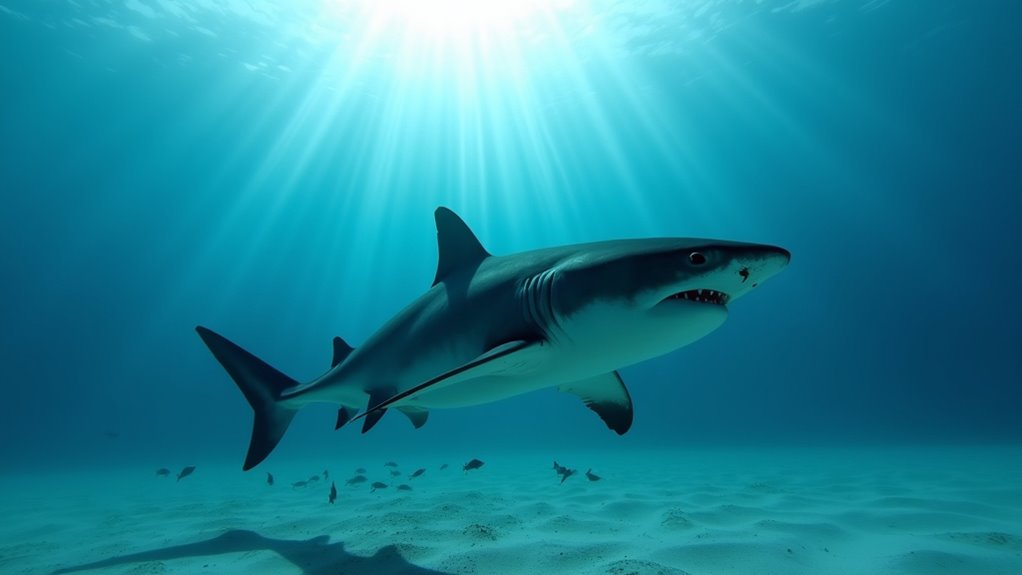
From great whites to bull sharks, the Atlantic teems with 11 fascinating predators that might surprise even seasoned ocean enthusiasts.
Yes, the Atlantic Ocean is home to numerous shark species. You’ll find iconic predators like the great white and tiger sharks alongside the lightning-fast makos and distinctive hammerheads. Bull sharks uniquely navigate both salt and freshwater, while blue sharks migrate vast distances seasonally. Other notable Atlantic residents include porbeagles, oceanic whitetips, and Atlantic sharpnose sharks. From coastal shallows to deep open waters, these diverse species showcase remarkable adaptations worth discovering.
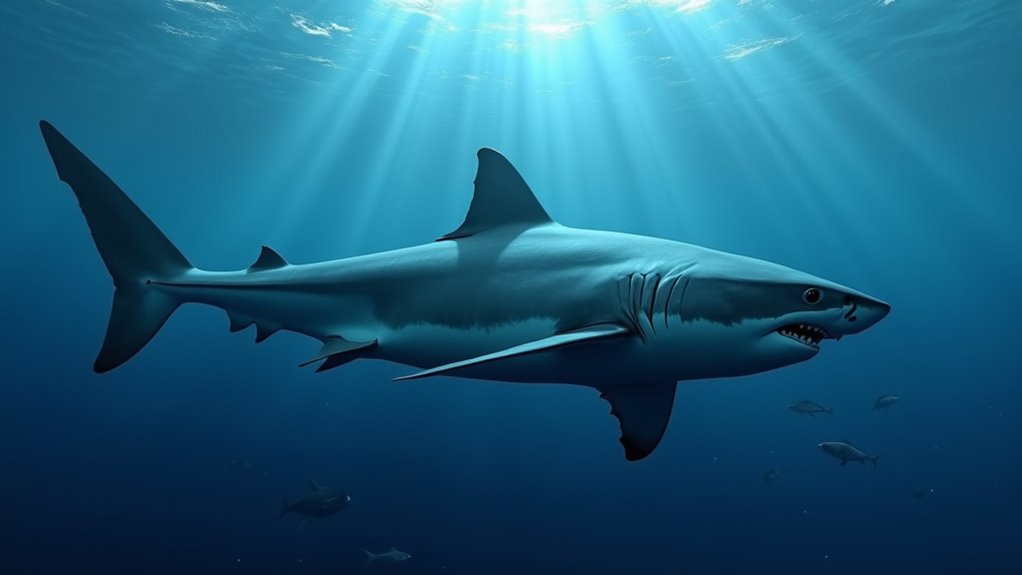
Known as one of the ocean’s most formidable hunters, the great white shark dominates the Atlantic waters as the region’s apex predator. You’ll find these powerful sharks throughout the western Atlantic from Newfoundland to Florida and in the eastern Atlantic from France to South Africa.
Great whites prefer water temperatures between 54°F and 75°F and can dive from the surface to depths exceeding 3,900 feet. They’re constantly on the move, undertaking impressive long-distance migrations for feeding and likely breeding purposes.
As vulnerable species on the IUCN Red List, great whites face threats from overfishing and accidental bycatch. Despite their fearsome reputation in media, these magnificent sharks play a vital role in maintaining the Atlantic’s ecosystem balance. Juvenile great whites spend their first year of life in the nursery areas off Long Island, where they can develop in relatively protected waters.
Conservation efforts are essential to protect these impressive ocean predators.
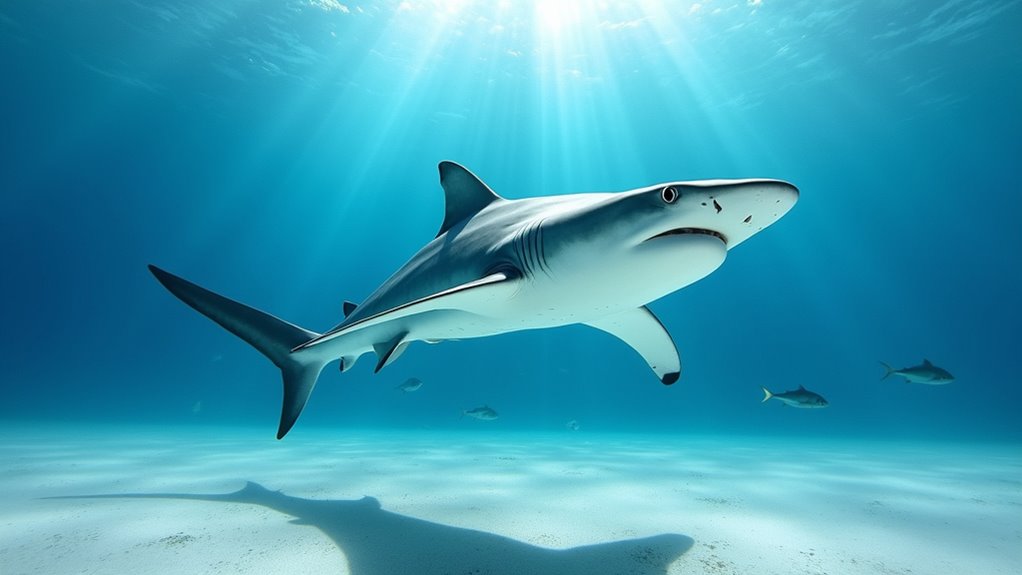
Among the most distinctive sharks in the Atlantic Ocean, hammerhead sharks stand out with their uniquely shaped heads that resemble a hammer or shovel. You’ll find several species in Atlantic waters, from New Jersey to Brazil in the west and from the Mediterranean to Namibia in the east.
The Atlantic’s hammerhead species include:
These remarkable predators prefer warm, shallow waters and play essential roles in maintaining marine ecosystems. The cephalofoil provides hammerheads with an evolutionary advantage by enhancing their sensory capabilities, allowing them to detect prey with greater precision.
Unfortunately, they’re threatened by commercial fishing, particularly the shark fin trade, and habitat degradation.
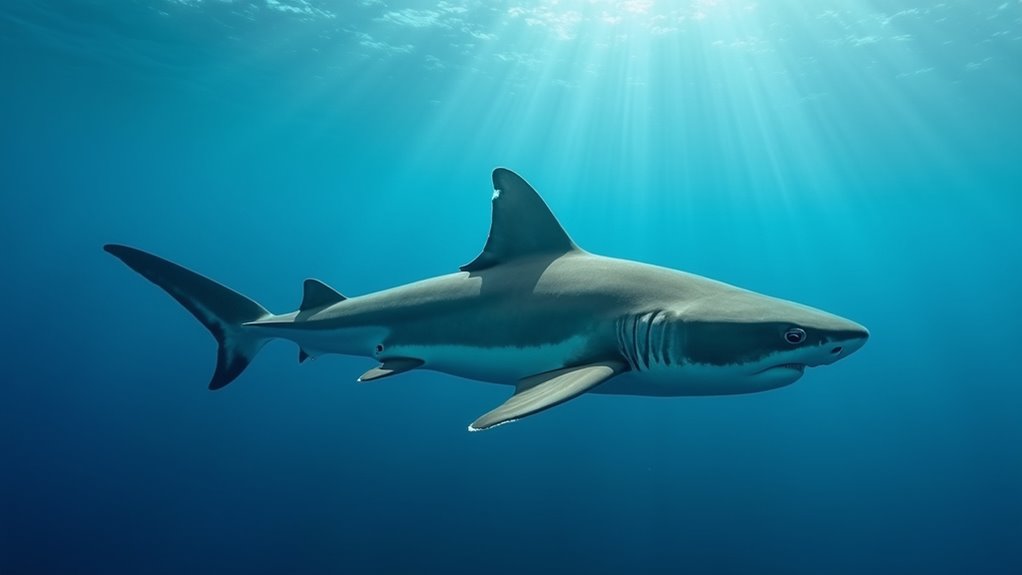
Once one of the ocean’s most abundant large predators, the Atlantic oceanic whitetip shark now faces a grim battle for survival. You’ll recognize this critically endangered species by its stocky body and distinctive white-tipped fins slicing through open waters.
From apex predator to extinction’s edge, the oceanic whitetip’s white-tipped fins now signal a species fighting to survive.
Growing up to 13 feet long and weighing around 200 pounds, these solitary hunters primarily feed on bony fish and squid in warm, tropical Atlantic waters far from shore.
Don’t expect to spot them near coastlines—they prefer the deep, pelagic zones.
Despite their slow-moving nature, oceanic whitetips are effective predators with a lifespan of up to 25 years. These sharks must keep swimming constantly to breathe properly since they cannot pump water over their gills when stationary.
Sadly, aggressive fishing practices targeting their fins have decimated populations, landing them on the IUCN Red List as critically endangered.
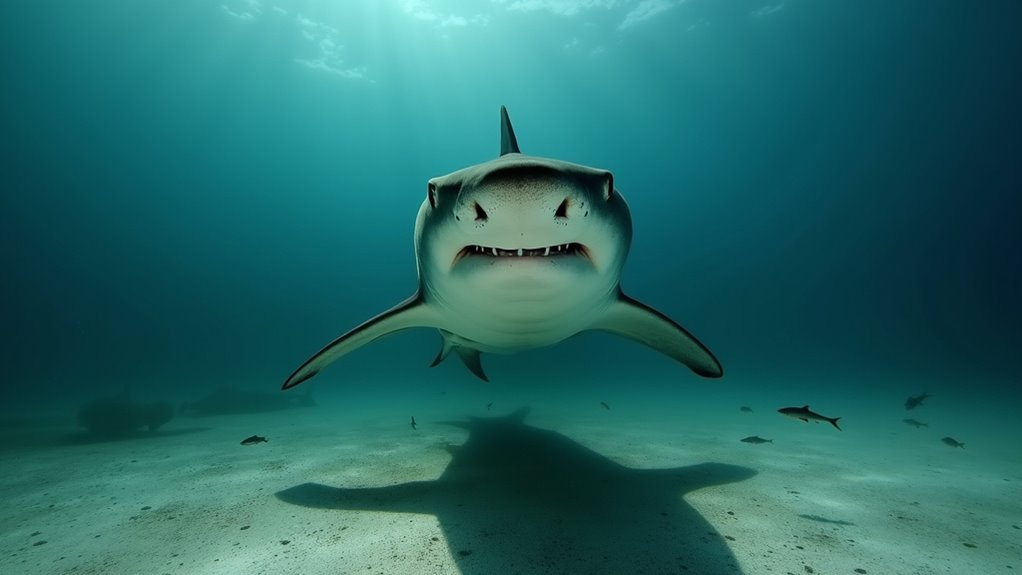
While oceanic whitetips rarely venture near shore, another remarkable Atlantic shark species actively crosses the boundary between ocean and river. Bull sharks possess an extraordinary ability to regulate their internal salt and water balance, allowing them to thrive in both environments.
When these adaptable predators swim upstream into freshwater:
You’ll find these 3.5-meter apex predators in coastal Atlantic waters, but they’ve been spotted hundreds of miles inland in rivers and lakes. Their unique osmoregulatory abilities make them one of the ocean’s most versatile hunters. These powerful hunters are known for their bump-and-bite strategy when pursuing prey, especially in murky waters with poor visibility.
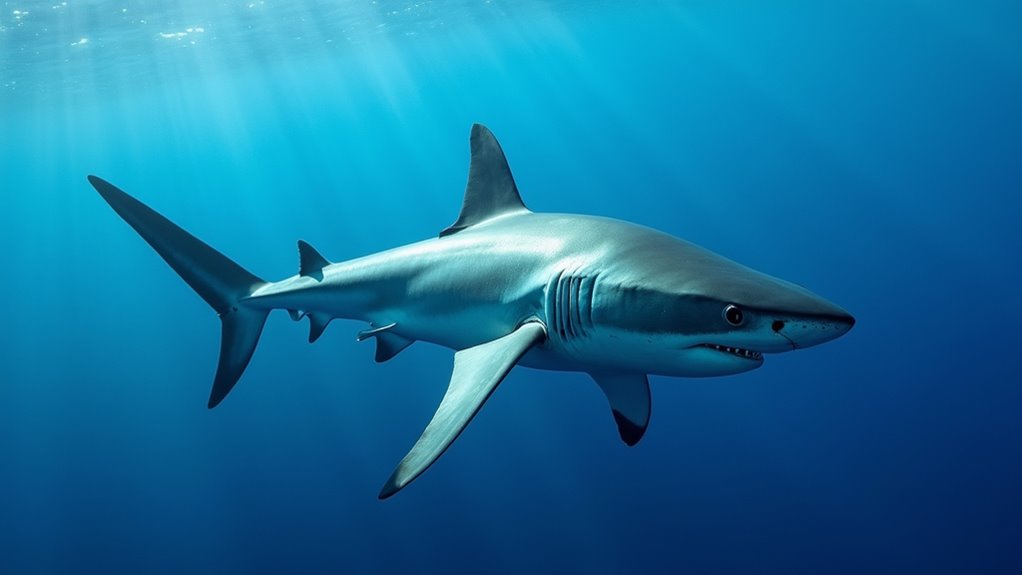
Cutting through the Atlantic’s blue waters at speeds that rival many land mammals, the mako shark stands as the ocean’s ultimate velocity predator. You’ll recognize these oceanic sprinters by their brilliant metallic blue tops contrasting with white undersides and their distinctive cylindrical, hydrodynamic bodies.
Reaching impressive bursts of 74 km/h, makos are often called the “cheetahs of the sea.” Their crescent-shaped tails and streamlined physique enable this remarkable speed, which they use to ambush prey—sometimes even leaping from the water during hunts. Their impressive power is supported by an endothermic heat exchange system that gives them advantages over cold-blooded prey.
You’ll find these solitary hunters throughout the Atlantic’s temperate and tropical waters, where they prey on fish and squid.
Unfortunately, they’re facing population declines due to overfishing, with conservation efforts struggling to keep pace with their vulnerable status.
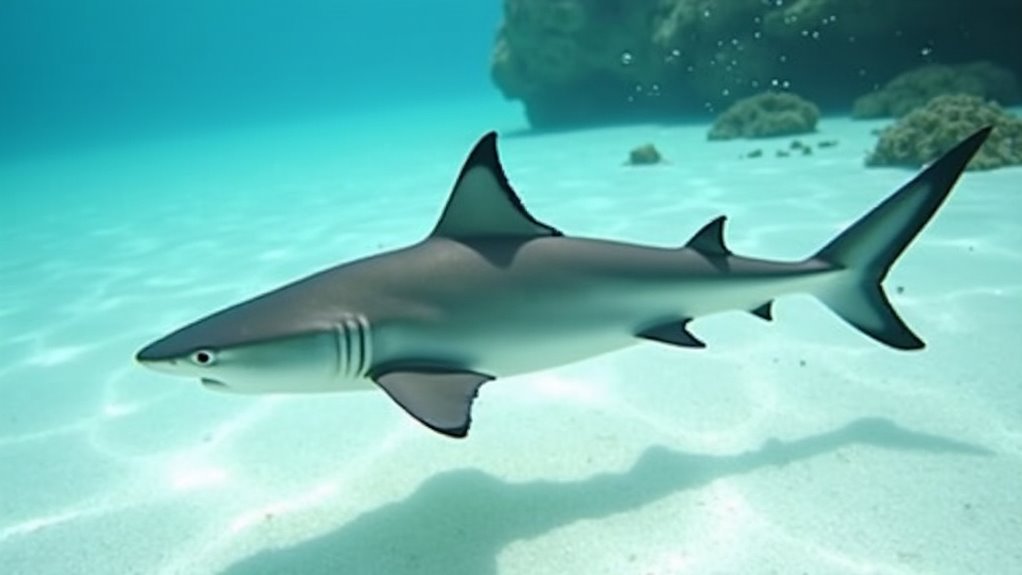
Unlike their open-ocean cousins, Atlantic blacktip sharks thrive in the shallow coastal waters along the eastern United States. You’ll find these sharks from Virginia down to Florida and throughout the Gulf of Mexico, typically in waters less than 30 meters deep.
These coastal dwellers are easily recognized by their:
Atlantic blacktip sharks migrate seasonally, heading north in summer and south in winter.
They’re adaptable creatures, tolerating low salinity in estuaries and mangrove swamps. These sharks show remarkable fidelity to natal nurseries, returning to their birthplaces to give birth to their own young.
The good news: their populations are well-managed in U.S. waters, making them a sustainable seafood choice and an important predator in coastal ecosystems.
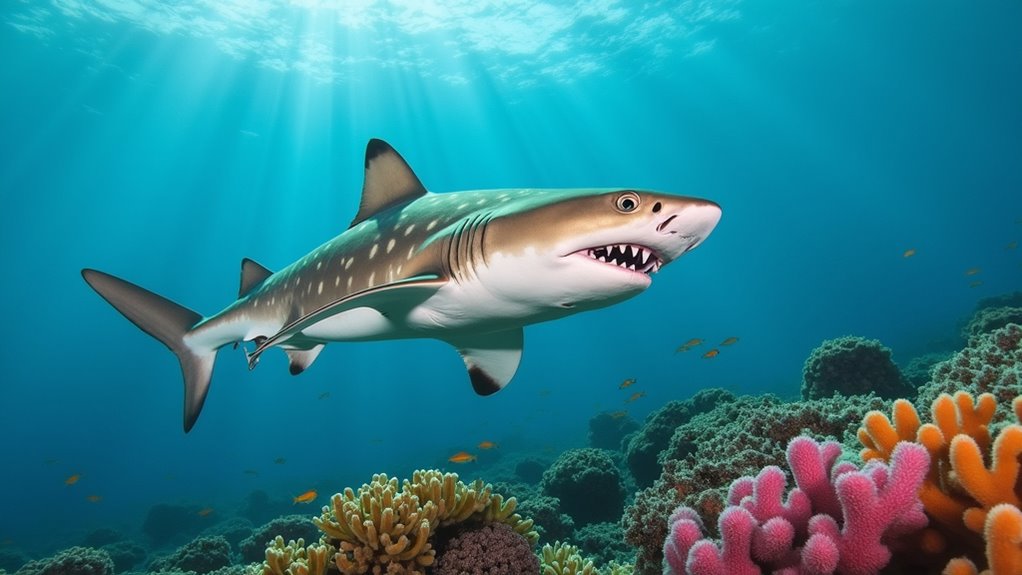
Despite their rows of menacing teeth that jut out in all directions, sand tiger sharks are among the most docile predators you’ll encounter in the Atlantic Ocean. These critically endangered sharks inhabit shallow coastal waters and reefs throughout temperate and tropical Atlantic regions, reaching depths of up to 191 meters.
The fearsome grin of the sand tiger shark belies its gentle nature in Atlantic waters.
You’ll recognize them by their bulky grey bodies with reddish-brown spots, pointy heads, and distinctive flattened snouts. Typically growing between 2.2-2.5 meters long, they’re primarily nocturnal hunters that prey on fish, crustaceans, and even other sharks.
Sand tigers have fascinating adaptations, including the ability to gulp air for buoyancy while hunting. Also known as grey nurse sharks in Australia, they’re popular subjects in public aquariums worldwide. They’re also known for their unique reproductive strategy—intrauterine cannibalism—where the strongest embryo consumes its siblings.
Despite their fearsome appearance, they’re commonly kept in aquariums due to their adaptable nature.
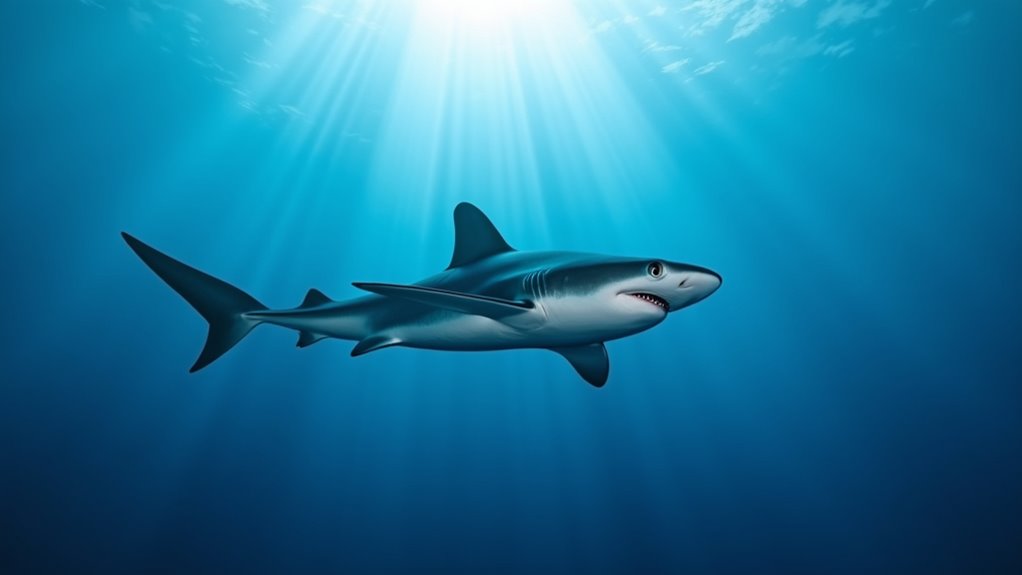
The sleek blue shark is prominent as one of the most widely distributed shark species on our planet, roaming all temperate and tropical oceans between 50°N and 50°S latitude. You’ll find these pelagic wanderers particularly common in Canadian Atlantic waters during summer and fall months.
These oceanic nomads prefer:
As blue sharks mature, they shift from moderate-nutrient waters to nutrient-poor environments. Female blue sharks often avoid intermediate temperatures of approximately 21.7-24.0°C, creating seasonal spatial separation from males.
Their impressive migratory patterns can take them thousands of kilometers annually, following major oceanographic systems.
While they’re highly abundant, they face threats from commercial fishing and bycatch, leading to their Near Threatened conservation status.
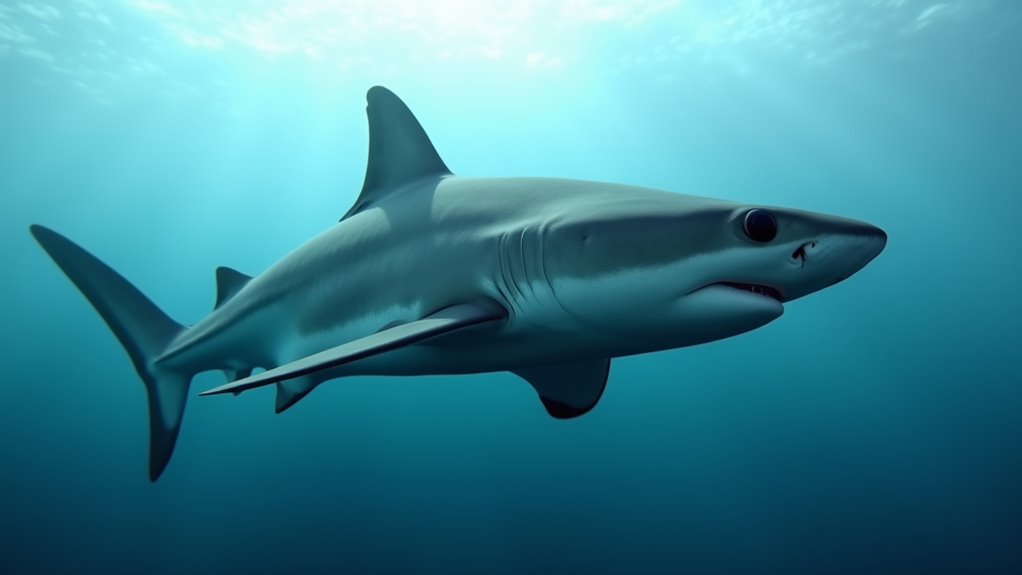
While blue sharks roam the warmer regions of the Atlantic, porbeagle sharks have adapted to thrive in much colder waters. You’ll find these streamlined predators primarily in the North and South Atlantic, typically between 30-70°N and 30-50°S latitudes, avoiding tropical areas entirely.
Unlike their blue cousins, porbeagle sharks thrive in the frigid Atlantic waters, staying well clear of the tropics.
Porbeagles prefer cold-temperate waters (1-18°C) and can dive remarkably deep—up to 1360 meters. Their blue-gray bodies, reaching lengths of 12 feet, are built for speed, allowing them to effectively hunt pelagic fish like herring and mackerel throughout the water column. These fascinating sharks maintain body temperatures 8-10°C warmer than the surrounding water through specialized circulatory adaptations.
Though they’re cold-water specialists, pregnant females will migrate to warmer areas like the Sargasso Sea to give birth.
While not endangered, porbeagles face threats from overfishing and are considered vulnerable, making conservation efforts increasingly important.
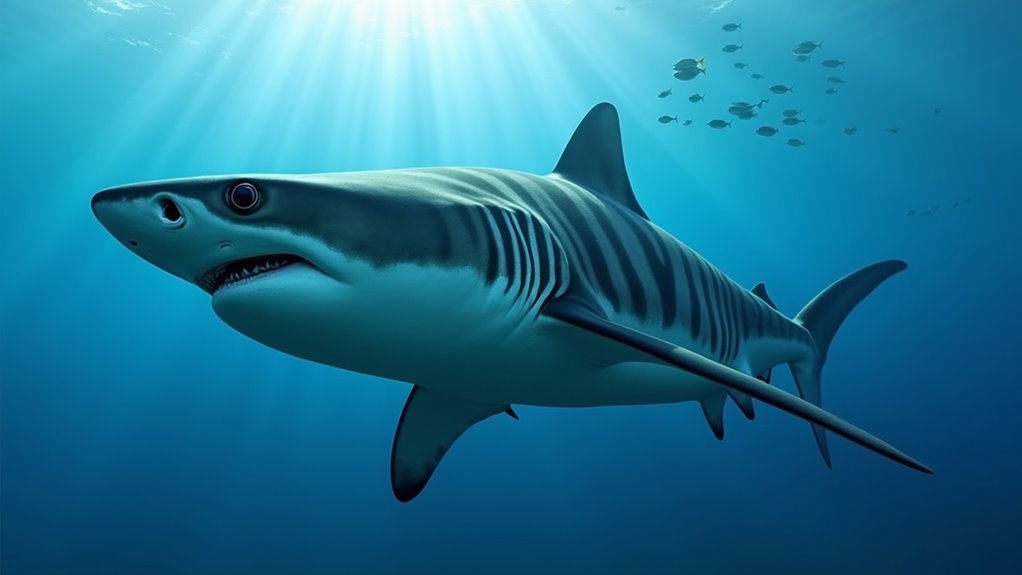
Renowned for their distinctive stripes and insatiable appetite, tiger sharks patrol both coastal and open waters throughout the Atlantic’s temperate and tropical regions. You’ll find these nomadic predators in murky coastal waters, estuaries, and harbors, often at depths between 2.5 to 145 meters.
Tiger sharks have earned their nickname as “garbage disposals” for good reason:
These powerful swimmers connect coastal and oceanic ecosystems, playing a crucial role in maintaining the Atlantic’s ecological balance. Their hunting strategy often involves using their serrated teeth to tear large prey into manageable pieces with saw-like head movements.
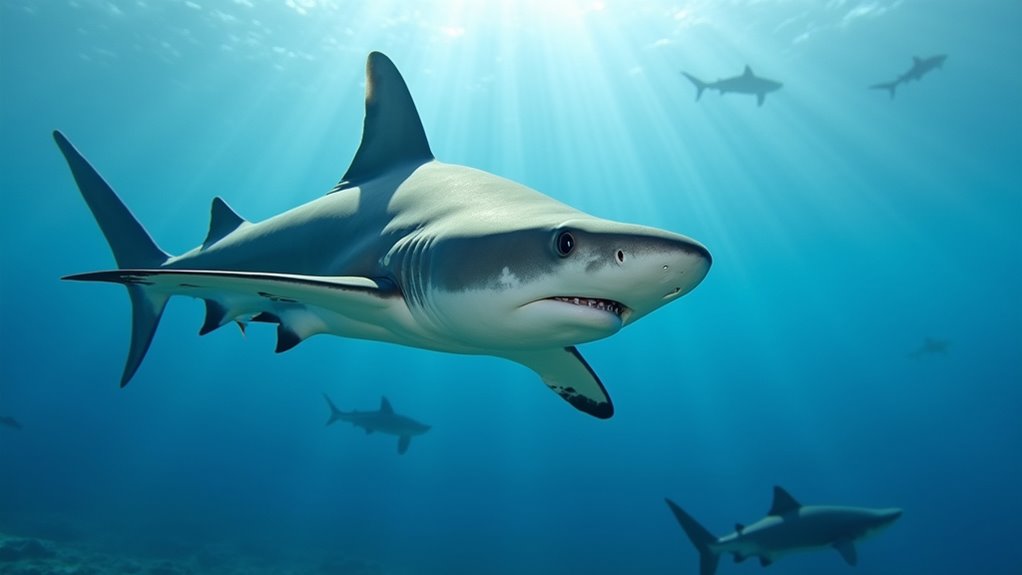
Despite their small stature, Atlantic sharpnose sharks represent one of the most abundant shark species throughout the western Atlantic Ocean. You’ll recognize them by their distinctive pointy snout, grayish body with white spots (in adults), and modest size of 3.5-4 feet.
These sharks inhabit warm waters from Canada to Brazil, typically in depths under 10 meters but occasionally diving to 280 meters. They form large, sexually segregated schools during their seasonal migrations, moving inshore to mate and offshore in winter. Their diet primarily consists of bony fish and crustaceans, reflecting their opportunistic feeding habits in coastal environments.
What’s remarkable about Atlantic sharpnose sharks is their sustainability. Their populations are neither overfished nor subject to overfishing, thanks to effective management practices.
As both predators of small fish and prey for larger species, they’re crucial components of the Atlantic’s marine ecosystem.
You’ve now glimpsed just a fraction of the Atlantic’s shark diversity. From the lightning-fast makos to the bizarre hammerheads, these creatures have adapted to every niche the ocean offers. Like pieces of a complex puzzle, they each play crucial roles in maintaining marine health. Next time you’re near Atlantic waters, remember—you’re sharing space with these remarkable predators, even if you don’t see their fins breaking the surface.